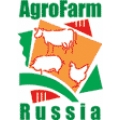 From 7 through to 9 February the All-Russian Exhibition Centre in Moscow hosted the International Exhibition for Animal Husbandry and Breeding.
From 7 through to 9 February the All-Russian Exhibition Centre in Moscow hosted the International Exhibition for Animal Husbandry and Breeding.
AgroFarm 2012. 278 companies from 24 countries presented an extensive range of innovative technologies and procedures for animal keeping and feeding. Animal health issues and modern genetics for beef, pig, poultry, goat and sheep-keeping also featured strongly. The number of exhibitors was up by 20 per cent over last year’s event. And at 12,270 m2, the exhibition floor space was 20 per cent larger this time round. AgroFarm has also become even more international, with a total of 45 per cent of exhibitors coming from outside Russia. The foreign country with the largest number of exhibitors – 53 companies in all - was Germany. Other countries such as Denmark, USA, France and the Netherlands also extended their range of exhibits, too. And there were some newcomers this year, such as Spain, Japan, Hungary, China and Kazakhstan. According to initial survey results, exhibitors and visitors were all extremely satisfied with AgroFarm 2012. The exhibition, with its excellent range of products and more than 40 side-events, plays an important role in terms of raising the competitiveness of Russia’s animal husbandry. AgroFarm is organised by DLG International GmbH, a subsidiary of DLG (Deutsche Landwirtschafts-Gesellschaft / German Agricultural Society) and the Moscow-based IEC of AREC.
More than 9,300 farmers, investors and experts from the agricultural sector
More than 9,300 farmers, investors and agricultural-sector professionals came to AgroFarm 2012; a five-per cent increase over 2011. The survey results amongst farmers and investors show that around two thirds of them are planning to make an investment in the next two years and one third even has concrete plans. At the top of the list are
husbandry techniques and the purchase of breeding animals. Other investment priorities include feeding techniques, animal housing construction and milking technology.
AgroFarm 2012 also had a major first-time attraction for visitors – an information centre on ‘Preventing mycotoxicoses in livestock and poultry’ which looked at the latest technologies and preventive strategies in the field of feed production and feed storage. Here visitors were able to find out more about products that can reduce the impact these pathogens have on the animal organism. Furthermore, they were also able to learn about techniques for determining the mycotoxin content in feed. The live presentations that accompanied all of this were a great favourite with the visitors. The range of information was rounded off by a specialist conference on the theme of mycotoxicose prevention.
Russia’s cattle breeders again made the most of the live demonstrations on hoof and udder care.
Technical programme with top-ranking figures and officials
The opening ceremony was attended by the Deputy Agricultural Minister of the Russian Federation, Schamil Vakhitov; the Chairman of the Federation Council Committee on Food and Agricultural Policies, Gennady Gorbunov; Chairman of the Board of the National Union of Milk Producers, Andrey Danilenko; Director IEC of AREC Valery Fedchukov; and the Managing Director of DLG International, Bernd Koch. The special forum dedicated to the question as to how we should go about generating an attractive investment climate for animal husbandry with a view to promoting its modernisation attracted wide-spread interest and was attended by the Deputy Agricultural Minister of the Russian Federation as well as by top officials from professional associations, some of the best managers from leading livestock companies and representatives from the field of science.
One of the issues discussed most intensively concerned the development of Russian animal production from the perspective of WTO accession. The expert analysis and forecasts were presented by the Agricultural Centre Director and Agricultural Economics Chair at Lomonosov Moscow State University, Sergey Kiselev, who has been involved in Russia’s WTO accession negotiations for the past 15 years. ‘Russian membership in the WTO could mean a one or two percentage point hike in imports for products of animal origin,’ explained Kiselev. ‘Further growth depends on other factors; first and foremost the competitive capacity of local produce.’
The meeting by the Russian-Danish Agrobusiness Club also generated quite a stir. Participants at this event included the Deputy Agriculture Minister, Ilia Schestakov, the Chairmen of the Russian-Danish Agrobusiness Club, Andrey Danilenko and Jan Laustsen, the Head of the Danish Veterinary Service, Dr. Per Henriksen, as well as more than 100 top Russian and Danish company managers interested in developing bilateral relations in the agricultural sector. At this meeting participants discussed the roll-out of an investment project in the Urals, specifically in Perm Oblast, that aims to set up a pig and cattle fattening farm, a meat-processing company and a dairy farm with a milk-processing facility.
AgroFarm is scheduled to take place again from 5 through to 7 February 2013 at the All-Russian Exhibition Centre in Hall 75.

February 16, 2012 - DLG International


